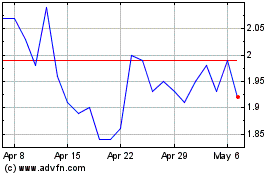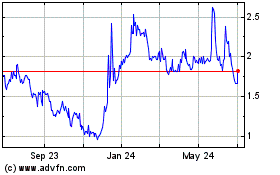Cognition Therapeutics Presents Scientific Rationale, Clinical Biomarker and Preclinical Data supporting a Phase 2 Clinical Trial with CT1812 in Geographic Atrophy Secondary to Dry AMD
December 01 2022 - 7:30AM

Cognition Therapeutics, Inc., (Nasdaq: CGTX), (the “Company” or
“Cognition”) today announced that the scientific rationale,
supporting proof-of-concept data and design of the planned Phase 2
trial of CT1812 in geographic atrophy (GA) secondary to dry
age-related macular degeneration (dry AMD) will be communicated in
an oral presentation at the 2022 Dry AMD Therapeutic Development
Summit. Age-related macular degeneration is the leading cause of
irreversible central vision loss in the world, with dry AMD
affecting an estimated 10 million people in the U.S., 1.5 million
of whom have advanced disease or GA.
“There are currently no approved drugs for dry AMD, and given
the severe consequence of disease and enormous patient population,
it’s imperative that we work towards a treatment,” added Lisa
Ricciardi, president and CEO of Cognition Therapeutics. “Complement
inhibition has shown potential in clinical trials but must be given
via intravitreal injection to each affected eye. We believe that a
noninvasive oral therapeutic with a novel mechanism of action that
can penetrate the blood-retina barrier and treat both eyes
simultaneously would be a significant advantage to the millions of
people at risk for permanent vision loss.” CT1812 is an
experimental oral sigma-2 (σ-2) receptor modulator currently in
Phase 2 clinical trials for both Alzheimer's disease and dementia
with Lewy bodies (DLB). An unbiased pathway analysis from two
Alzheimer's disease clinical trials identified GA and macular
degeneration as two diseases most significantly associated with
proteomic changes in CT1812- vs placebo-treated patient biofluids.
Further analysis of the proteomes identified key proteins and
pathways impaired in dry AMD and GA that were significantly
impacted by CT1812 treatment, providing evidence that a σ-2
receptor modulator may have therapeutic potential in dry AMD.
Subsequently, in vitro studies were conducted using RPEs derived
from induced pluripotent stem cells (iPSC) that were exposed to
amyloid beta oligomers and oxidative stress. Results from these
studies demonstrated that administration of CT1812 can rescue the
ability of RPEs to recycle photoreceptor outer segments (POS), a
vital process that is damaged by stressors including oxidative
stress and pathogenic proteins.
“The proteomic analyses from our clinical studies in
neurodegenerative disease were instrumental in identifying dry AMD
as an indication of interest,” explained Mary Hamby, Ph.D., VP of
biology at Cognition Therapeutics. “Published genetic and
preclinical findings from independent laboratories supported the
role of the σ-2 receptor in dry AMD and our data provide evidence
that modulation of the σ-2 receptor may protect sensitive RPE cells
and rescue functional deficits. Our next step is to test this novel
mechanistic approach in the clinic.”
Based on several lines of evidence including these clinical
proteomic analyses and preclinical data in RPE cell models,
Cognition has entered discussions with the U.S. Food and drug
Administration (FDA) to initiate a Phase 2 clinical trial in over
200 people with GA. The full complement of evidence supporting
Cognition's advancement of CT1812 into the clinic, along with the
design of the proposed Phase 2 study, will be presented at the Dry
AMD Therapeutic Development Summit.
Presentation details:
|
Date/Time: |
|
December 1, 2022 |
| Title: |
|
Targeting the Sigma-2 Receptor
(S2R) for Dry AMD with an Oral Small Molecule Approach: Preclinical
& Clinical Biomarker Support |
| Author: |
|
Vice President of Research,
Mary Hamby, Ph.D. |
About Dry Age-related Macular DegenerationDry
AMD affects an estimated 10 million people in the U.S., 1.5 million
of whom have advanced disease or geographic atrophy. Dry AMD is
characterized by a progressive deterioration of the macula, a
region of the retina comprised of photoreceptors, specialized
neurons that convert light into electrical signals, and a layer of
retinal pigment epithelial (RPE) cells, which forms the
blood-retinal barrier and provides essential support functions to
photoreceptors. Macular deterioration is believed to be caused by
several factors, including oxidative stress, inflammation and the
buildup of protein deposits called drusen, which form on the
Bruch’s membrane below the RPE. A key function performed by RPE
cells is the recycling of photoreceptor outer segments (POS). This
process is impaired in dry AMD, resulting in the eventual loss of
photoreceptors, which in turn leads to irreversible vision
loss.
About Cognition TherapeuticsCognition
Therapeutics, Inc. is a clinical-stage biopharmaceutical company
engaged in the discovery and development of innovative, small
molecule therapeutics targeting age-related degenerative disorders
of the central nervous system and retina. We are currently
investigating our lead candidate CT1812 in clinical programs in
Alzheimer’s disease, dementia with Lewy bodies (DLB) and dry
age-related macular degeneration (dry AMD). We believe CT1812 and
our pipeline of σ-2 receptor modulators can regulate pathways that
are impaired in these diseases. We believe that targeting the σ-2
receptor with CT1812 represents a mechanism functionally distinct
from other current approaches in clinical development for the
treatment of degenerative diseases. More about Cognition
Therapeutics and its pipeline can be found
at https://cogrx.com/
Forward-Looking StatementsThis press release
contains forward-looking statements within the meaning of The
Private Securities Litigation Reform Act of 1995. All statements
contained in this press release, other than statements of
historical facts or statements that relate to present facts or
current conditions, including but not limited to, statements
regarding our cash and financial resources and our clinical
development plans, are forward-looking statements. These statements
involve known and unknown risks, uncertainties and other important
factors that may cause our actual results, performance, or
achievements to be materially different from any future results,
performance, or achievements expressed or implied by the
forward-looking statements. In some cases, you can identify
forward-looking statements by terms such as “may,” “might,” “will,”
“should,” “expect,” “plan,” “aim,” “seek,” “anticipate,” “could,”
“intend,” “target,” “project,” “contemplate,” “believe,”
“estimate,” “predict,” “forecast,” “potential” or “continue” or the
negative of these terms or other similar expressions. We have based
these forward-looking statements largely on our current
expectations and projections about future events and financial
trends that we believe may affect our business, financial
condition, and results of operations. These forward-looking
statements speak only as of the date of this press release and are
subject to a number of risks, uncertainties and assumptions, some
of which cannot be predicted or quantified and some of which are
beyond our control. Factors that may cause actual results to differ
materially from current expectations include, but are not limited
to: competition, our ability to secure new (and retain existing)
non-dilutive grant funding, our ability to grow and manage growth,
maintain relationships with suppliers and retain our management and
key employees; our ability to successfully advance our current and
future product candidates through development activities,
preclinical studies and clinical trials and costs related thereto;
the timing, scope and likelihood of regulatory filings and
approvals, including regulatory approval of our product candidates;
changes in applicable laws or regulations; the possibility that we
may be adversely affected by other economic, business or
competitive factors; our estimates of expenses and profitability;
the evolution of the markets in which we compete; our ability to
implement our strategic initiatives and continue to innovate our
existing products; our ability to defend our intellectual property;
the impact of the COVID-19 pandemic on our business, supply chain
and labor force; and the risks and uncertainties described in the
“Risk Factors” sections of our filings with the Securities Exchange
Commission. You should not rely on these forward-looking statements
as predictions of future events. The events and circumstances
reflected in our forward-looking statements may not be achieved or
occur, and actual results could differ materially from those
projected in the forward-looking statements. Moreover, we operate
in a dynamic industry and economy. New risk factors and
uncertainties may emerge from time to time, and it is not possible
for management to predict all risk factors and uncertainties that
we may face. Except as required by applicable law, we do not plan
to publicly update or revise any forward-looking statements
contained herein, whether as a result of any new information,
future events, changed circumstances or otherwise.
Contact Information:Cognition Therapeutics,
Inc. info@cogrx.com Aline
Sherwood (media) Scienta
Communications asherwood@scientapr.com Daniel
Kontoh-Boateng / Rosalyn Christian (investors) Tiberend
Strategic Advisors, Inc. dboateng@tiberend.com /
rchristian@tiberend.com
Cognition Therapeutics (NASDAQ:CGTX)
Historical Stock Chart
From Aug 2024 to Sep 2024

Cognition Therapeutics (NASDAQ:CGTX)
Historical Stock Chart
From Sep 2023 to Sep 2024
